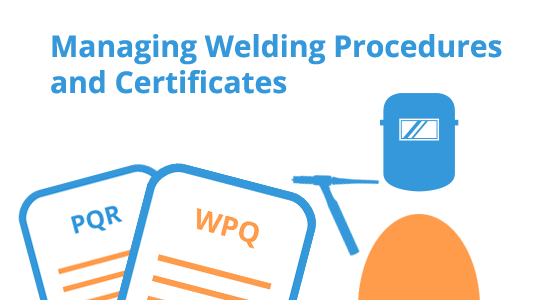Managing welding procedures and certificates
As a Welding Engineer, one of the most time consuming functions is to manage a company’s welding certifications, but because the industry standards say so, it’s not something you can overlook.
Usually this involves having stacks of paper files with all the documents inside. Even if you have them organized by metals, welding process, or certificate number, going through these files is not an easy task.
How did we work around these issues?
I always try to be proactive in this sense, so I started filling out some excel spreadsheets with the certificates and procedures’ essential variables, which is a good starting point.
You can always opt for a specialized software solution, or perform this task with paper (which I do not recommend), especially when you are considering doing work under different standards (e.g. ISO 15614-1, ASME IX, AWS D1.1). What really becomes difficult is when you have to work under product standards such as ASME B31.3, EN 1090-2, or with specific contract requirements, and you have to add some non-essential variables to the whole mix.
One specific detail that caught me off-guard was when our welding specification for a project under EN 13480 included a WPS / PQR with charpy-V notch tests that only reached 35J on a stainless steel at -196ºC (ISO 15614-1 only requires 27J minimum, but EN 13480 states that stainless steels require a minimum of 40J, regardless of the temperature they will be operating).
This was with TIG and MMA welding processes, and it meant either requalifying this procedure or use the ones with TIG only. Eventually it was decided that no further procedures would be qualified, which led to a productivity loss.
In the end, we were caught off-guard by a small detail in our tools for managing our certifications, which is why you should store as many variables in your system as possible. My recommendation for a basic system would be to keep track of the following PQR variables:
- Certificate Number
- Standard
- Joint Type
- Base Materials
- Filler Materials
- Welding Processes
- Diameter
- Thickness
- Product Type (Pipe/plate)
- Welding Position
- Welding details (single or both sides, backing or no backing)
- Average Heat Input
- Preheat temperatures
- Postweld heat treatment temperatures
- Impact test temperatures
- Hardness requirements
With these you should be able to cover most regular jobs, while the more specialized projects may require you to go through your files of paper certifications to investigate some more details.
What about welder certificates?
Welder Certificates are usually the most tiresome part of all the management of these welding certifications. Why? Well first of all the sheer size of it can outnumber PQR by 20 to 1 (alright these might be extreme values, but it does happen sometimes), and the mandatory requalification process that standards enforce. Don’t get me wrong, this is mostly a good thing, but it is somewhat cumbersome.
My approach to welder certificates
Well, luckily you don’t have to work with product standards such as ASME VIII or EN 1090-2 for welder certificate requirements (well, most of the times you don’t).
One thing you definitely have to worry about is that welders are a human resource, and as such, your top welder with certifications for pretty much everything can be gone on the next day (he might not even be gone, he might just be working on a foreign project, without being able to weld on the shop you are managing).
But we are talking specifically about certifications, and as such, my system with the variables I used for managing the welder certificates (before WeldNote), was as follows:
- Certificate Number
- Standard
- Welder
- Emission Date
- Internal Requalification Date
- External Requalification Date
- Joint Type
- Supplementary Fillet Weld Test (for ISO 9606-1)
- Base Materials
- Filler Materials
- Welding Processes
- Diameter
- Thickness
- Product Type (Pipe/plate)
- Welding Position
- Welding details (single or both sides, backing or no backing)
With the Internal and External Requalification Dates I used a simple conditional formatting rule for MSExcel with the “TODAY” command that allowed me to be aware of their requalification periods. It wasn’t perfect, but it worked. This only becomes a problem with medium to big-sized companies, where you’d have to manage around 2000 welder certificates. In my case there were around 600 so it was manageable, even if hard.
This was one of the reasons for the creation of WeldNote (or at least the very first iteration of WeldNote), managing welder certificates is actually a pretty serious task and should not be taken lightly. Aside from the cost of each welder certificate (base material, welder’s time, the inspector’s cost, etc), your clients might not accept a welder certificate that wasn’t controlled and revalidated for a certain period and that may carry an additional cost.
With WeldNote’s first version I was able to manage all these 600 active certificates at the same time, knowing every day which ones I had to send to the notified body and the ones that had to be revalidated internally. Most welding softwares allow for this, but I found that they lacked some usability of ease at some points.
By the way, if all this is an issue for you, maybe you’d like to check WeldNote, Welding Management Software. It is a software application for the management of all welding documentation that was created to aid in these tasks, saving valuable time to welding engineers.
Anyway this is my perspective on the management of welding certifications, how do you manage your company’s certificates? Leave a comment down below in the comment section!
Best Regards,
– Tiago Pereira
CEO of WeldNote, Welding Management Software

